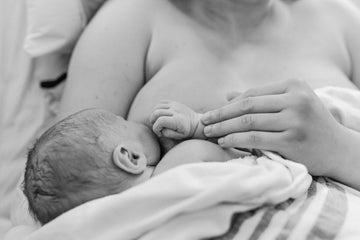Postpartum Fertility: What to expect from your menstrual cycle after you give birth
Nov 30, 2023

Photo by Wendy Mulder
What to expect from your menstrual cycle after you give birth
By Crisia Tabacaru, PhD, CFSP
Postpartum fertility can be tricky to understand. But it doesn't have to be! Let’s break it down.
Menstrual cycle basics
The menstrual cycle is made up of two phases: the follicular phase and the luteal phase. The follicular phase starts with Day 1 of menstruation (your period) and goes until you ovulate. It is dominated by estrogen rising from growing follicles (follicles house eggs) in your ovaries. The first day after ovulation to the day before your next period is the luteal phase, dominated by progesterone from the corpus luteum (the empty follicle that has released an egg) in your ovaries. Progesterone is not produced unless ovulation takes place. 
Pregnancy is essentially an extended luteal phase that lasts until you give birth. When you get pregnant the corpus luteum continues to produce progesterone until the placenta is developed enough to take over that function.
When you give birth, you clear out the contents of your uterus and you can think of this like menstruation for the purposes of understanding cycles postpartum: you start a new cycle on the day of the birth. While pregnancy is an extended luteal phase, postpartum is an extended follicular phase until ovulation returns.
After you give birth, your cycle goes back to square one. After the lochia phase, the ovaries are stimulated to produce estrogen again, which will eventually trigger ovulation; but when you actually ovulate again depends on breastfeeding practices. The hormone prolactin is produced while breastfeeding, and it rises and falls with breastfeeding frequency. Prolactin suppresses ovulation, and breastfeeding can thus delay the return of fertility for as long as 15 months (when ecological breastfeeding is practiced). When prolactin is lower, your body may attempt to ovulate, but be suppressed again as prolactin rises. This may happen many times before ovulation succeeds. If you are not breastfeeding, ovulation can occur as early as 6 weeks after birth (rarely, earlier).
Natural child spacing
Although this struggle between hormones may sound menacing, breastfeeding suppressing ovulation is ultimately good for your body, and has been termed natural child spacing. Both pregnancy and lactation, especially the breastfeeding demands of early postpartum, require a lot of resources and are taxing for the body. To have them occur simultaneously is not an easy feat, and your body is smart. If a new pregnancy would be too difficult for the mother and/or the current baby, it may be better to wait. So don’t worry. It’s all normal and healthy, even if it’s complicated.
Return of fertility
OK, back to the technicalities.
During ovulation attempts, estrogen rises and you may see patches of cervical mucus as your cervix responds to the rising hormones. Eventually an attempt will succeed, estrogen will rise high enough to trigger a surge of luteinizing hormone (LH—the hormone that is detected by ovulation tests), and you will release an egg. Woo!! If you’re a cycle charting nerd, you might be celebrating.
This first ovulation will likely be followed by a shorter than normal luteal phase before your first period. This is normal, and short luteal phases may last a few cycles. The next cycle will also likely have a longer than normal follicular phase (the lead up to ovulation), as your body gets used to cycling again. Within about 6 cycles, you will most likely see a full return of fertility with your regular cycle length.
Not all bleeding is menstruation
But wait. To make things a bit more confusing, it’s fairly common to bleed without ovulating during the postpartum period. If you don’t ovulate, the bleed is not menstruation, though you would likely not be able to tell if you are not charting your cycle. If estrogen rises for a while, but prolactin doesn’t allow ovulation to occur, there is still a built-up uterine lining from the estrogen that will shed when estrogen falls again. This is called estrogen withdrawal bleeding. It’s not the same thing as menstruation, which is the shedding of uterine lining that has been built up by both estrogen and progesterone.
So what can you do with all this information?
Cycle charting
Charting your cycle, the practice of noting your body’s biomarkers every day in a chart, can demystify postpartum fertility by showing you which days are infertile, which days are potentially fertile, and when ovulation finally occurs. While postpartum fertility can be more complicated than regular cycles, it doesn’t have to be confusing if you are charting. It is possible to confidently understand what is happening with your cycle, it is possible to avoid taking unnecessary pregnancy tests, and it is possible to know exactly when your first period is coming, whether that’s 2 months or 15 months after you give birth.
Get in touch
If you’d like to learn how to chart your cycle postpartum for health, avoiding pregnancy, or achieving pregnancy again, or if you’d simply like to learn more about your fertility and cycles, book a consult with Crisia.
- cycle charting,
- fertility specialist,
- fourth trimester,
- fourth trimester support,
- menstrual cycle,
- menstrual cycle basics,
- new mom support,
- postnatal recovery,
- postpartum,
- postpartum fertility,
- postpartum menstrual cycle,
- postpartum plan,
- postpartum planning,
- postpartum recovery,
- postpartum resources,
- postpartum support



